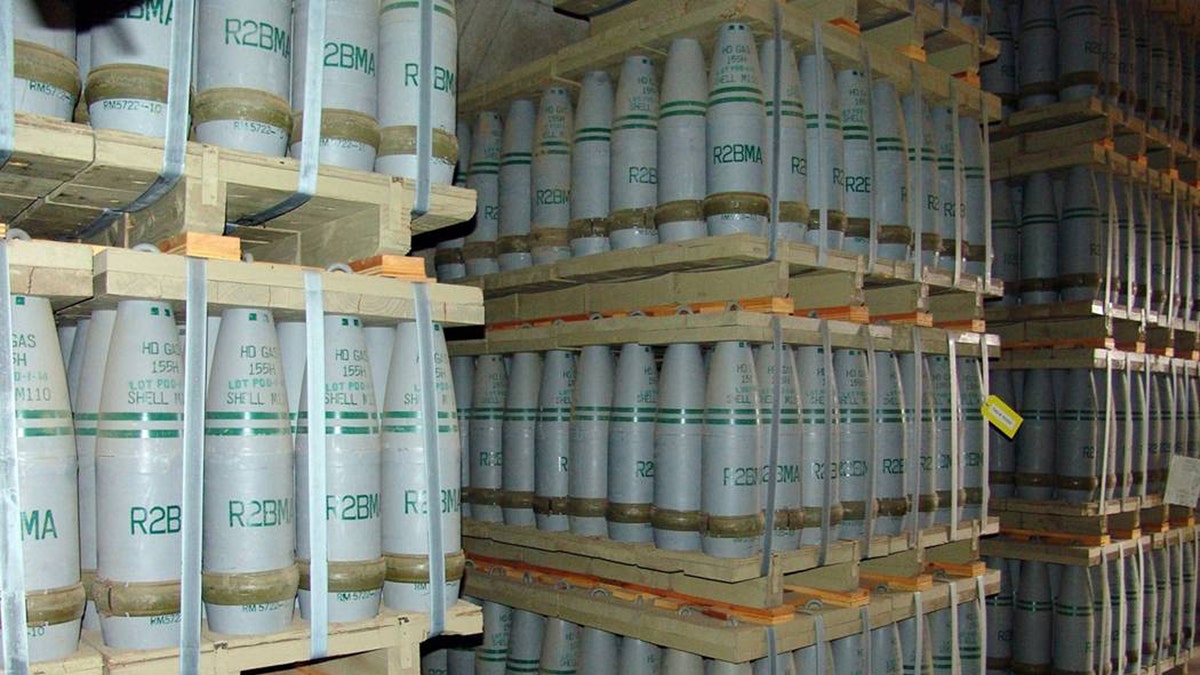
File photo. Mustard gas-filled 155mm projectiles are seen inside a chemical storage igloo, at the Pueblo Chemical Depot in an undated photo provided by the U.S. Army Chemical Materials Activity (CMA) in Pueblo, Colorado. (REUTERS/U.S. Army Chemical Materials Activity/handout via Reuters)
Chemical weapons are in the news this week with the U.S. military destroying caches of the armaments.
New research is also keeping the weapons in the spotlight. Scientists say that they have discovered a new, fast way to destroy chemical weapons and possibly protect the U.S. military and first responders.
Northwestern University researchers have developed a new material that destroys nerve agents at high speeds. In fact it is so effective, it can render one of the most toxic nerve agents in the world, Soman, impotent within mere minutes.
Military designation GD, or Soman, is a clear, colorless nerve agent similar to the more commonly known Sarin. Nerve agents are the most toxic of known chemical warfare agents. Soman isn’t odorless; it can smell like rotting fruit or camphor. Even just a tiny bit of it on the skin can be fatal within minutes.
The team’s research suggests that the new material will also be effective against other agents like the odorless and tasteless VX. VX is easy to make and considered the most potent of all known nerve agents. Any liquid contact on skin could be lethal.
How does the material work?
The robust material is comprised of a zirconium-based metal-organic framework inspired by biological catalysts. When it encounters a chemical weapon threat, the porous structure can capture and store a large amount of the toxic gas. While it is captured, the catalyst destroys the threat very quickly.
The Northwestern University team says this is the first successful deployment of zirconium metal organic frameworks against nerve agents. Their research was published by the journal Nature Materials on March 16.
Protecting the military
This new material could be used for warfighters’ protective equipment like gas masks. Protective equipment is essential to keep military personnel safe when they are working in environments where there is a potential use of chemical weapons.
When first responders enter an environment where there may be nerve agents like Soman or VX, the CDC recommends using a NIOSH (National Institute for Occupational Safety and Health)-certified Chemical, Biological, Radiological, Nuclear (CBRN) Self Contained Breathing Apparatus (SCBA) with a Level A protective suit.
Announcing this new way to defeat chemical weapons, research leader and Northwestern University chemistry research professor Omar K. Farha stressed its versatility: "The material can be in water or a very humid environment, at a temperature of 130 degrees or minus 15, or in a dust storm. A soldier should not need to worry about under what conditions his protective mask will work. We can put this new catalyst in rugged conditions, and it will work just fine."
"Simple changes to the nerve agent's molecular structure can change something that can kill a human into something harmless,” he added. “GD and VX are not very sophisticated agents, but they are very toxic. With the correct chemistry, we can render toxic materials nontoxic."
Bioscavengers and micro rockets
In the latter half of last year, there were a number of other promising developments in protecting warfighters from chemical weapons. Bioscavengers and micro rockets get full marks for creativity, utility and effectiveness.
A research team at the University of Tennessee at Knoxville made significant progress in this area, creating a prophylactic drug called bioscavengers.
The team is taking a squid enzyme and modifying so that it more rapidly and effectively destroys nerve agents. This enzyme is a protein that is not naturally found in the human body.
The bioscavengers are engineered enyzmes that can destroy the threats they encounter. This drug could be taken before entering a war zone where chemical weapons may be unleashed. When a warfighter encounters a threat, he or she would be protected from its toxicity since the bioscavenger would neutralize the weapon, preventing suffering and fatalities.
The University of Tennessee scientists have collaborated with Oak Ridge National Laboratory, and a French national laboratory on the project.
In October 2014, a University of California, San Diego research team announced its breakthrough in the Defense Threat Reduction Agency-funded micro rockets project. These rockets destroy chemical and biological warfare agents like Sarin and Anthrax. And get this – these rockets use seawater for fuel.
How small is a micro rocket? They are micrometer-sized – as in one millionth of a meter.
When the rockets are exposed to seawater, they automatically create a bubble and swim around in it decomposing the threat. Eventually, the rockets degrade by themselves.
Each rocket is made from magnesium coated with titanium dioxide. Titanium dioxide has already been very effectively used to break down pollutants. It has also been tried for other applications like self-cleaning clothes.
One of the advantages of this approach is that it doesn’t yield any toxic waste material.
It is hoped the rockets will be faster and cheaper than traditional approaches and the research is now looking at deploying the micro rockets to clean mega areas of threats.
Interestingly, this advance may hold promise for other unexpected applications such as, for example, deploying a system in the human body to eliminate cancer cells.
Ballet dancer turned defense specialist Allison Barrie has traveled around the world covering the military, terrorism, weapons advancements and life on the front line. You can reach her at wargames@foxnews.com or follow her on Twitter @Allison_Barrie.
